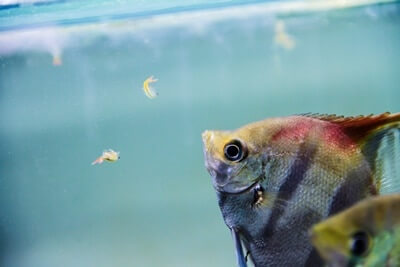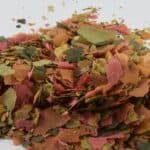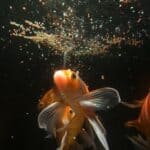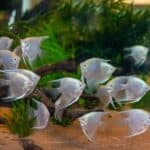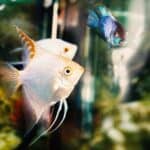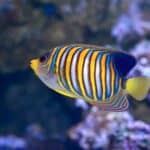Last Updated on: 22nd February 2023, 11:12 pm
Angelfish are hardy creatures, but they require a specific diet to thrive. In the wild, they feast on live prey in the form of shrimp and other fish. In most home aquariums, they’re just given fish flakes to round out their diet. However, this can be dangerous, as your angelfish may become underfed and lacking in nutrients. This will cause them to lose their vibrant coloring and be more susceptible to illness.
Angelfish eat a variety of meat and plants. This includes flakes, pellets, live food, frozen food, freeze-dried food, and some fresh vegetables. Food must be high in protein and fiber. So, bloodworms, brine shrimp, white worms, and mealworms are ideal. You can also feed angelfish peas, small chunks of cucumber, and even spinach.
Chicken and beef can be offered for their protein content, but only in moderation. Freeze-dried and frozen foods are easy to come by, but you lose some nutrients by preserving them. Angelfish must be fed 2-3 times a day, with juveniles needing 3-4 meals each day. In between meals, your angelfish will snack on algae, any coral that’s available, and even smaller fish. If they go without food for 3 days or more, they will die.
What Do Angelfish Eat?
Angelfish are omnivores, meaning they can eat plants and meat alike. However, angelfish do show a preference toward meat. That’s because they require a high amount of protein, according to the Journal of Applied Biological Sciences.
To help accommodate that, their diet should mainly consist of meat products. This helps to fuel their active lifestyles and improve their coloring. Without it, angelfish can suffer from:
- Stunted growth
- Lethargy
- Dimmer stripes and patterns
- A weakened immune system
Can Angelfish Eat Fish Flakes?
Angelfish can eat flakes, but you must choose the type carefully. These omnivores can easily become sick if:
- They’re given fish flakes and nothing else
- The fish flakes lack the right amount of protein
- The fish flakes have added preservatives
- The flakes have unnecessary coloring or hormones mixed in
With that in mind, it’s recommended that owners mix up the diet:
- You should only choose high-protein flakes or pellets from brands that are designed for cichlids.
- These should be paired with frozen, freeze-dried, and live food.
- You can then top it off with certain kinds of plants.
Ideally, the plants will mirror what angelfish eat in both ocean reefs and freshwater rivers. If you can’t find kelp and seaweed (or lack the budget for it), though, traditional vegetables will do.
All that’s left is to put the entire diet together in the right portions. A good rule of thumb for angelfish is to:
- Feed a staple food as 60% to 70% of the angelfish diet
- Feed the rest as 30% to 40% of the diet
We’ll now explore the best foods to offer your angelfish:
Flakes and Pellets
Flakes and pellets are the go-to options. Most of them are created by grinding up and combining:
- Shrimp meal
- Earthworms
- Squid meal
- Fish meal
- Vitamins
- Minerals
Your angelfish will gain many of the nutrients found in live or frozen foods. However, these ratios will not provide everything your angelfish needs. Fish flakes and pellets must still be incorporated with live or frozen food.
Likewise, all pellets or flakes must be protein-rich for your angels. You’ll find them branded as “cichlids flakes” to help keep these hunters well-fueled. The brand you pick should lack added hormones, by-products, fillers, or artificial pigments. Otherwise, your angelfish will become prone to bloating, constipation, or other illnesses.
Spirulina-based pellets are another great option. They offer plant-based protein and cater to the omnivorous side of the angelfish. These can be used off-and-on throughout the week. Just be sure your angelfish receive meat-based pellets or flakes more often.
Live Food
Technically speaking, angelfish do not require live food. As long as they’re given enough protein from frozen or freeze-dried food, as well as flakes, they will be fine.
With that said, angelfish thrive on a varied diet. Live food gives them a chance to hunt. It also imbues them with added fiber and trace nutrients that are lost in the freezing or drying process.
Because of this, it’s recommended to give angelfish live food once every 1-2 weeks. This should consist of:
- Brine shrimp
- Bloodworms
- Black worms
- Mealworms
- White worms
Angelfish are notorious for eating fish that can fit in their mouths, especially in their natural habitat. Because of this, you can offer feeder guppies occasionally.
Just be extra careful when choosing live food for your angelfish. Options should be purchased from a trusted and certified source. If not, the live food may contain harmful parasites that can cause diseases in your angelfish.
Vegetables
In the wild, angelfish nibble on plant life to round out their diet with extra vitamins and nutrients. If you can mimic this exactly, you should.
However, it’s often more expensive and difficult to source that kind of food. That’s why most owners substitute it with vegetables from your kitchen. Angelfish may be picky about the taste or texture, but options include:
- Zucchini
- Peas
- Cucumber
- Lettuce
- Spinach
These veggies should be prepared, so that your angelfish can digest them. The process will involve:
- Boiling the veggies until they’re soft
- Cutting them into tiny pieces, so they can fit into the mouths of your angelfish
- Offering them in moderation
If your angelfish don’t eat the entire portion, then remove leftovers. You can freeze and thaw them again later.
Frozen Food
In that vein, frozen food is the main choice for owners. This allows you to buy veggies and live food in bulk, store it over several weeks, and offer it to your angels in batches. It also rules out the chance of parasites or bacteria thriving on the food and then getting transferred to your fish.
Be sure to thaw any food before giving it to your angels. Otherwise, your angelfish may struggle to digest it and become constipated.
Frozen food isn’t as nutrient-rich as live food. However, it still satisfies the needs of your angelfish.
Freeze-Dried Foods
Freeze-dried foods are similar to frozen foods, except they are dehydrated. As a result, the food can lose some of its nutritional value, but it gains sterility. This prevents the food from getting infected with parasites and keeps your angelfish tank disease-free. Angelfish like to feed on freeze-dried:
- Brine shrimps
- Mystic shrimps
- Bloodworms
You have to submerge the freeze-dried food in water for around 10 minutes before offering it to your angelfish. If you fail to do so, the food will expand inside the angelfish’s stomach and cause serious health issues.
How Much Food Do Angelfish Need?
Adult angelfish must be fed 2 times a day. Watch how much your fish eat within the first 2 minutes to figure out portion sizes. That is the amount that you should feed them twice a day.
Meanwhile, juvenile angelfish require more food and nutrients in order to thrive and grow. They should be fed 3-4 times each day. Fry also require more live food as they develop and will later adapt to flakes or pellets.
If you’re trying to breed angelfish, then you should offer the mated pair food 3-4 times a day. This will help them produce healthier fry and avoid eating the eggs.
How Long Can Angelfish Go Without Food?
Angelfish can survive for 3 days without food. However, leading up to this, you will notice multiple health problems developing in your tank.
As the angelfish notice a food shortage, they will become very aggressive. Fighting will break out across the tank, which may lead to injuries. As hunger sets in, the fish will become lethargic, dim in color, and sickly. Eventually, they will die.
This timeline varies depending on the age and size of your fish. For instance, if you have a young angelfish, it will live no more than a day without food. Healthy, adult angelfish are more likely to endure for the full 3 days.
Because of this, you should maintain a strict feeding routine. If the angelfish are pressed, they may even consume other fish in the tank to survive. If they cannot physically eat larger fish, they may still kill them in a desperate attempt.
What Do Angelfish Eat In The Wild?
In the wild, angelfish eat a large portion of meat and a small amount of plant life. That pairs well with their aggressive nature and skill in hunting. Angelfish use their sleek form and impressive swimming speeds to ambush prey. This includes creatures such as:
- Small insects
- Small crustaceans
- Invertebrates
- Worms
- Plankton
- Small fish that fit into their mouths
What Plants Do Angelfish Eat?
Angelfish will substitute a part of their diet with plant life. In the sea and in rivers, there are many options, such as:
- Hydroids
- Sponges
- Seaweed
- Coral
- Kelp
Of course, many of these foods balance the line between animals and plant life. This helps to further empower an angelfish’s high protein needs.
What Corals Do Angelfish Eat?
Oceanic angelfish live in and around coral reefs. Like most fish species that call these areas home, they also feed on the coral as a source of nutrients.
However, coral is never a primary source of food for angelfish. In many cases, they just nibble and graze on corals, instead of actually eating them. Their favorite types include:
- Large-polyp stony corals
- Tridacnidae
- Zoanthids
- Calm mantle corals
- Soft corals
If you want to add coral to your tank, then expect your angelfish to take a bite. It will serve as a passing snack, rather than a full meal, so angelfish don’t typically damage coral.
Do Angelfish Eat Algae?
Angelfish will eat algae. It is a plant-based food that provides angelfish with calories, minerals, and other nutrients.
Since angelfish have big appetites, you might find them nibbling on trace algae from around their tank in between meals. However, it isn’t their favorite food. They won’t control the algae levels of your tank like bottom-feeding fish.
Algae will also lack the amount of nutrients that angelfish require to stay alive. They will prefer turning on other fish in the tank rather than eating algae alone.
So long as your angels are well-fed, they’ll treat algae as no more than a snack. They prefer to nibble on:
Slime Algae
Slime algae have a very self-explanatory name when it comes to appearance. It looks like slime, mostly found as small green dots accumulated together. In a tank, this kind of algae is found on walls and internal fixtures.
Slime algae may quickly overwhelm a tank. However, angelfish can limit the spread, while other bottom-feeding fish actually solve the problem.
Fuzz Algae
Fuzz algae appear in the form of long strands. These wisps are thick and easily noticeable. Fuzz algae may even be used as a decoration, as long as its growth and spread are controlled.
That can make it an ideal snack for your angelfish tank. The occupants will nibble on the strands and create hiding places around the algae.
Thread Algae
Thread algae is similar to fuzz in appearance, but the threads are much thinner. Also known by the name “filamentous algae,” this type is slow-growing and unlikely to take over your aquarium. If you choose to host it as a decoration, your angelfish will enjoy nibbling on this snack and limiting its growth.
Do Angelfish Eat Meat?
In your tank, angelfish can broaden the range of meat they eat. For example, good sources of protein include:
- Chicken
- Beef
The portions must be pea-sized and well-cooked.
With that said, beef and chicken should not become a regular part of their diet. Their bodies aren’t naturally adapted to eating chicken or beef in the wild. They can enjoy a short-term protein boost, but overfeeding can result in digestive issues.
What Fish Do Angelfish Eat?
In the wild and in communal aquariums, angelfish feed on smaller fish that they can fit in their mouth. This includes:
- Guppies
- Danios
- Tetras
As cichlids, angelfish will expand their list of prey based on what’s available. They are prone to aggression and can hunt, antagonize, and wear down even larger fish. If they can’t fit the creature into their mouths, they are likely to ignore the kill and let other fish consume it.
Do Angelfish Eat Mysis Shrimp?
Angelfish love eating mysis shrimp, as well as brine shrimp. Mysis shrimp can even be used as their primary food source, but not for prolonged amounts of time.
The shrimp contains high amounts of fat, protein, vitamins, and minerals. With that said, the fat content may become overwhelming if your angelfish eat nothing else.
Do Angelfish Eat Neon Tetras?
Neon tetras also have protein, vitamins, and minerals that your angelfish will enjoy. Their tiny size makes them easy to snatch up. Because they congregate in schools, angelfish will strike through the center and chase down stragglers.
Do Angelfish Eat Snails?
Angelfish can eat snails. However, it’s not a common occurrence, since most snails kept in tanks are large in size. This makes it difficult for angelfish to get their mouths around the creatures. That only leaves tiny or baby snails as an ideal target.
Do Angelfish Eat Their Babies?
Angelfish do eat their babies, but their offspring are not considered a primary food source. Instead, angels usually resort to cannibalism when they’re:
- Stressed
- Out of other food
- Overcrowded
It’s similar to when angelfish attack larger fish that cannot be eaten. They are simply trying to defend their territory and eliminate competition for food. So long as your angels are kept well-fed, they should have no reason to eat their neighbors or children.
Angelfish rely on a broad and varied diet. From plant life to meat, they will thrive when you switch up their diet. Be sure to offer pellets, flakes, live food, frozen food, and pieces of fresh vegetables.

